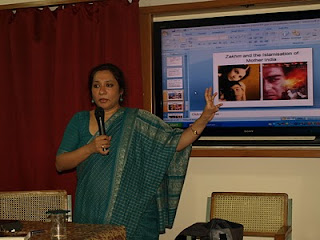Speaker: To enlighten the students on the undercurrents and hidden agenda of cinema, NISCORT had Mrs. Karen Gabriel as its guest speaker for the 115th session of world around. Mrs. Karen Gabriel, an author and associate professor at St. Stephen’s college, University of Delhi spoke about Historicizing Cinema, Gendering the Nation.
Issues covered: The session aimed at understanding cinema not as entertaining celluloid but actually as an industry. The term Bollywood has become the national mainstream cinema of the country despite of the fact that the Indian film industry is not limited to the Hindi cinemas only. The melodramatic features of nationalism, integrity, gender, politics etc makes the Hindi cinema prominent. The Indian film industry together produces 800-1000 films in about 20 different languages in a year. It is expected to experience the growth rate of INR 175 million from INR 84 million by 2012. Hindi films have become global in a very deliberate way because of its marketing strategies, huge network and great involvement of corporate industries. The class bias and gender bias of Indian cinema were analyzed in depth in the background of the Indian social ethos and traditional values.
of the fact that the Indian film industry is not limited to the Hindi cinemas only. The melodramatic features of nationalism, integrity, gender, politics etc makes the Hindi cinema prominent. The Indian film industry together produces 800-1000 films in about 20 different languages in a year. It is expected to experience the growth rate of INR 175 million from INR 84 million by 2012. Hindi films have become global in a very deliberate way because of its marketing strategies, huge network and great involvement of corporate industries. The class bias and gender bias of Indian cinema were analyzed in depth in the background of the Indian social ethos and traditional values.
Presentation style: The lecture was delivered using presentation software such as Microsoft PowerPoint. Although PowerPoint method is widely used these days, Ms. Gabriel encouraged an active learning atmosphere with the use of colorful pictures.
Evaluation: The lecture allowed students to form a different perspective of Cinema. The students identified with the topics and cleared their doubts regarding representation of northeastern people in Hindi cinema, negative influence of melodrama in our society as well as stereotyping in films. Ms. Gabriel provided an opportunity for a two-way exchange of information by her effective presentation and brilliant answers.
Issues covered: The session aimed at understanding cinema not as entertaining celluloid but actually as an industry. The term Bollywood has become the national mainstream cinema of the country despite
 of the fact that the Indian film industry is not limited to the Hindi cinemas only. The melodramatic features of nationalism, integrity, gender, politics etc makes the Hindi cinema prominent. The Indian film industry together produces 800-1000 films in about 20 different languages in a year. It is expected to experience the growth rate of INR 175 million from INR 84 million by 2012. Hindi films have become global in a very deliberate way because of its marketing strategies, huge network and great involvement of corporate industries. The class bias and gender bias of Indian cinema were analyzed in depth in the background of the Indian social ethos and traditional values.
of the fact that the Indian film industry is not limited to the Hindi cinemas only. The melodramatic features of nationalism, integrity, gender, politics etc makes the Hindi cinema prominent. The Indian film industry together produces 800-1000 films in about 20 different languages in a year. It is expected to experience the growth rate of INR 175 million from INR 84 million by 2012. Hindi films have become global in a very deliberate way because of its marketing strategies, huge network and great involvement of corporate industries. The class bias and gender bias of Indian cinema were analyzed in depth in the background of the Indian social ethos and traditional values.Presentation style: The lecture was delivered using presentation software such as Microsoft PowerPoint. Although PowerPoint method is widely used these days, Ms. Gabriel encouraged an active learning atmosphere with the use of colorful pictures.
Evaluation: The lecture allowed students to form a different perspective of Cinema. The students identified with the topics and cleared their doubts regarding representation of northeastern people in Hindi cinema, negative influence of melodrama in our society as well as stereotyping in films. Ms. Gabriel provided an opportunity for a two-way exchange of information by her effective presentation and brilliant answers.
No comments:
Post a Comment